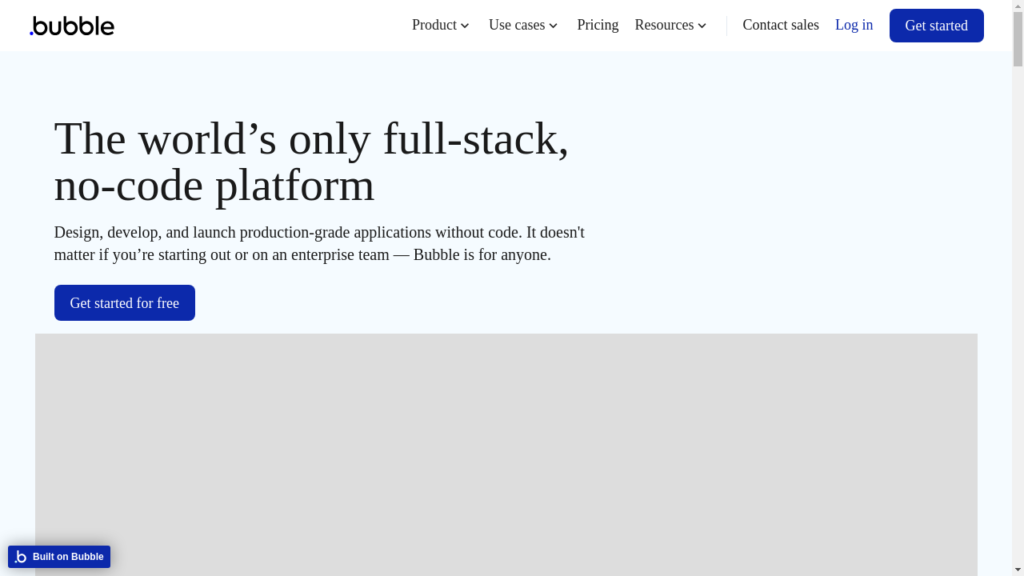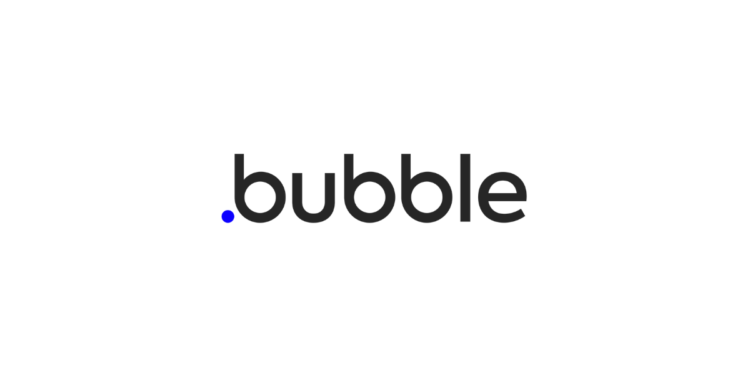Have you ever wondered how to create an app without coding skills? Look no further than Bubble. It’s a platform that lets beginners build their own apps easily.
In this guide, we’ll explore what Bubble is and how you can start your app-building journey. Whether you have a great idea for a new application or just want to flex your creative muscles, Bubble could be the perfect tool for you.
Let’s dive in and discover app development with Bubble.

What is Bubble?
Bubble is a user-friendly platform for designing, launching, and integrating web applications without coding.
It stands out with its no-code approach, making it accessible to users of all backgrounds and expertise levels.
Bubble offers high standards in design and functionality, being dermatologist tested, cruelty-free, and vegan.
The platform is backed by research, plant-based, and preservative-free.
Its biodynamic design ensures easy navigation, like in an animated movie with gravity-defying bubbles in Tokyo.
Bubble is a creativity playground with organic integrations.
Sign up, design, and launch with Bubble for a seamless web application development experience.
Getting Started with Bubble
Creating an account on Bubble.io
Creating an account on Bubble.io is simple. Just provide your email address and create a secure password.
The platform is user-friendly, catering to both developers and individuals without coding experience. Once your account is set up, you can easily design, launch, and integrate your projects.
Bubble.io is known for its high standards, offering a research-backed no-code platform. They prioritize being cruelty-free, vegan, and organic, meeting the needs of a plant-based lifestyle.
The platform also integrates products like Bahari teas, Solana Beach, and Courier Elixirs, enhancing the user experience. New arrivals like Premola Granola and Lottie’s Meats are also supported, appealing to users in cities like Philadelphia, Vancouver, and Boise.
Understanding the interface of Bubble
Bubble’s interface has various components. They help users design and launch applications easily.
Users from different cities like Los Angeles and New York can find organic and cruelty-free options on Bubble. For example, teas from Bahari in Vancouver or Premola Granola from Boise.
Products on Bubble are dermatologist tested and vegan. They meet high standards and are backed by research.
In cities like Denver and Solana Beach, users can explore offerings like Lottie’s Meats, Copina Co, and Savor by Suzie.
Bubble’s interface allows users to navigate effortlessly, similar to a movie. With intuitive design and developer integrations, users can easily access and manipulate features.
By signing up, users can use Bubble’s no-code platform to create applications. These applications can defy gravity, like at a Tokyo playground where young people can speak and connect.
From fly by Jing in Salt Lake City to Curious Elixirs in Philadelphia, Bubble provides a unique space for innovation and exploration.
Building Your First App with Bubble
Choosing the template for your app
When choosing a template for your app, consider factors like the target audience, overall goals, and purpose of the app.
The design of the template should match the intended user experience and functionality of the app.
By selecting a template that appeals to the app’s audience, developers can create a more engaging platform.
For instance, if the app targets young people in Tokyo, a vibrant and interactive template with elements like bubbles or animations might be more appealing.
Ensure that the chosen template meets high standards like being cruelty-free, dermatologist tested, and plant-based to enhance the app’s credibility and user trust.
By carefully selecting a template that reflects the essence of the app, developers can optimize their design, launch, and user integrations.
Adding design elements to your app
Adding design elements to your app can be made easier by following these steps:
- Consider incorporating organic and plant-based themes to align with current trends.
- Use cruelty-free and dermatologist-tested colors and fonts to appeal to a wider audience.
- Ensure the design is backed by research to meet high standards and provide a seamless user experience.
- Avoid preservatives in your color schemes and fonts by opting for biodynamic and vegan options.
- Choose colors and fonts that resonate with different cities like Los Angeles, New York, and Philadelphia to create a universal appeal.
- Think about unique animations and bubbles to enhance the visual appeal of the app and make it stand out.
- Remember to speak to a diverse audience by incorporating various themes like Bahari, Mavuno Harvest, and Copina Co.
- Consider utilizing a no-code platform to easily launch your app with integrations that meet design tools’ laws of gravity.
- Partner with developers to review and optimize the design for a seamless user experience.
- Sign up for new arrivals and enjoy free shipping for a successful app launch.
Integrating workflows and logic using Bubble
When looking into integrating workflows and logic using Bubble, there are several strategies to consider.
- Developers can leverage the platform’s no-code capabilities to streamline the design process and ensure a smooth launch.
- By using Bubble’s no-code platform, users can easily create complex integrations without the need for extensive coding knowledge, making it accessible to a wide range of individuals.
- Utilizing Bubble’s high standards for quality, including being dermatologist tested, cruelty-free, and vegan, developers can ensure that their app meets stringent criteria.
- Attention to detail extends to the ingredients used in the app, focusing on organic, biodynamic, and plant-based elements.
- Incorporating features such as preservative-free formulas, users can trust that the app is backed by research and meets the needs of consumers looking for clean and sustainable options.
Tips for Creating a Successful Bubble App
Optimizing the performance of your Bubble app
To optimize your Bubble app’s performance and ensure a smooth user experience, consider these steps:
- Analyze and address potential bottlenecks or issues affecting performance.
- Focus on enhancing speed and efficiency for a seamless experience.
- Back up actions with practical examples like reviewing design and launch processes.
- Developers using the no-code platform may review integrations in Los Angeles to improve performance.
- Ensure the app meets organic and cruelty-free standards found in New York or Vancouver.
- Prioritize plant-based and biodynamic elements, aligning with user values in places like Denver or Solana Beach.
- Optimize the app by paying attention to detail and focusing on the user experience.
Testing and debugging your Bubble app
To make sure the Bubble app works well, it’s important to test it thoroughly for bugs and errors.
Use debugging tools to find and fix any issues quickly.
Test the app on different devices and screen sizes to make sure it works properly everywhere.
Maintain high standards by using products with dermatologist-tested, cruelty-free, plant-based ingredients.
Brands like Bahari teas and Lottie’s Meats offer such ingredients.
Check if the app follows organic and biodynamic principles that companies like Copina Co and Mavuno Harvest promote.
Remember to meet the expectations of consumers in cities like Los Angeles, New York, and Philadelphia.
This includes reviewing design, integrations, and performance.
Consider launching new products with free shipping to stay competitive.
Research and planning are key for the app to succeed in the online world.
Incorporating user feedback for app improvement
User feedback is valuable for app developers. Creating a review platform where users can share their thoughts helps developers understand what works and what can be improved. Analyzing these reviews using AI algorithms can reveal common trends and areas for enhancement.
After collecting user feedback, developers can prioritize features based on the frequency and severity of issues raised. This approach guides future updates and ensures a seamless user experience. Utilizing a no-code platform aligned with cruelty-free product standards can help quickly design and launch new integrations.
Developers can integrate user feedback into new features or products tailored to different locations, such as teas from New York or Bahari from Vancouver, catering to users in places like Boise, Denver, or Warrenville. Maintaining cruelty-free and vegan practices, meeting standards like dermatologist-tested and plant-based criteria, can be achieved by leveraging user input.
By following a transparent and research-backed approach, developers can continuously evolve the app. This evolution creates an engaging digital playground for young people, similar to the concept of bubbles defying gravity in Tokyo.
Common Challenges in Bubble App Development
Dealing with data management issues in Bubble
To address data management issues in Bubble, one can implement efficient strategies.
Developers on the platform can streamline data handling by:
- Utilizing integrations
- Ensuring high standards for design and launch
- Backing decisions with research
For example, a developer in Los Angeles working on an organic tea subscription app called Bahari can use Bubble to design a seamless user experience. This includes quick access to new arrivals and free shipping.
Efficient data management can be ensured by incorporating integrations with cruelty-free suppliers like Copina Co from New York and Lottie’s Meats from Boise.
By adhering to strict standards such as being dermatologist tested and vegan, this team in Vancouver can maintain a platform that is both user-friendly and trustworthy.
Moreover, granting easy sign-up options can enhance the user experience in handling data seamlessly.
Ensuring compatibility across different devices
Developers can make sure their Bubble app works on different devices by using responsive design techniques, adjusting the layout based on screen sizes and resolutions.
Organic design principles can help create an appealing app that adjusts to various displays, providing a consistent user experience from Los Angeles to New York.
Testing the app on emulators or real devices in locations like Vancouver, Boise, and beyond can help find compatibility issues.
Incorporating Bahari teas’ range of teas, including Premola Granola, and cruelty-free practices supported by research can improve compatibility.
Vegan ingredients like Eve and cruelty-free products from Warrenville can also enhance the user experience.
Creating the app with high standards, free of preservatives and biodynamic elements like Fly By Jing products, can cater to the diverse needs of users in cities such as Solana Beach, Denver, and Hermosa Beach.
Focusing on dermatologist-tested products like Lottie’s Meats and Copina Co can ensure the app is skin-friendly and accessible nationwide, meeting the needs of consumers in cities like Salt Lake City, Philadelphia, and New Arrivals.
Integrating no-code platforms with preservative-free elements like Savor by Suzie and Curious Elixirs can simplify the compatibility testing process.
Launching the app with a focus on design and user experience can exceed users’ expectations.
Questions to Ask Before Launching Your Bubble App
Is my app user-friendly and intuitive?
The app is designed to be user-friendly. It’s easy to navigate through sections like Los Angeles, New York, Vancouver, and Denver.
The app features cruelty-free teas from Bahari and vegan options from Lottie’s Meats. It focuses on intuitive functionality for a smooth experience in finding products like Mavuno Harvest and Copina Co.
Whether in Boise, Warrenville, or Salt Lake City, the app offers dermatologist-tested products supported by research for a plant-based lifestyle.
Users can sign up easily to discover new arrivals like Bubbles and Animation. The developer integrated the app with platforms like Curious Elixirs to maintain a user-friendly experience.
With a review system like Savor by Suzie and Fly by Jing’s preservative-free options, users in cities like Philadelphia and Hermosa Beach can share the app’s ease of use.
This makes the app a fun place for young people to enjoy, especially with the movie Tokyo.
Have I tested my app thoroughly for bugs and errors?
Testing an app for bugs and errors is a detailed process. It needs careful attention and a thorough approach.
Developers must think about all scenarios and user interactions. This ensures a smooth user experience.
Regression tests are important. They check that fixes or changes haven’t caused new problems.
Testing boundary conditions, edge cases, and error handling is crucial. It helps find and fix potential bugs that could disrupt the app.
Comprehensive testing helps developers find and solve issues before launching the app. This ensures users have a great experience.
It’s important to uphold high standards and deliver a bug-free app that works well on different platforms.
Next Steps After Building Your Bubble App
Deploying your app on a web server
Deploying your app on a web server involves a few steps.
- First, design the app on a platform like Bubble. Bubble is a no-code platform that allows users to create applications without coding.
- Once the app is designed, sign up and launch it on the web server.
- Integrations with other services may be needed to enhance the app’s functionality.
- Consider using high-quality ingredients like those found in Bahari or Premola Granola teas to meet high standards.
- Make sure the app is dermatologist-tested, vegan, and plant-based to cater to different users.
- Reviewing the app’s performance is crucial, similar to how animated movies are reviewed before release.
By following these steps and considering these factors, developers can ensure their app deployment is successful and meets their target audience’s needs.
Promoting and marketing your Bubble app for maximum reach
Developers can promote a Bubble app through various strategies for maximum reach. Here are some easy-to-read suggestions:
- Use social media platforms like Instagram, Facebook, and Twitter to boost visibility.
- Engage with users by sharing updates on new arrivals, teas, and products like Bahari, Copina Co, and Curious Elixirs.
- Create interactive and appealing content by incorporating user-generated content and reviews from places like Hermosa Beach, Denver, and Vancouver to build credibility.
- Launch targeted ad campaigns in cities like Philadelphia, Los Angeles, and Boise to reach a wider audience.
- Ensure the app is backed by research, dermatologist-tested, cruelty-free, and vegan to appeal to consumers interested in sustainable and ethical products.
- Focus on organic, plant-based, and biodynamic ingredients like Mavuno Harvest or Lottie’s Meats to demonstrate commitment to high standards.
- Offer free shipping and sign-up incentives to attract users and explore the innovative features of the Bubble app, such as animation and unique design elements.
FAQs
Bubble is a no-code platform that allows you to easily create web and mobile applications without any coding experience. It provides a visual interface for designing apps, integrating databases, and deploying projects quickly. With Bubble, you can build custom apps like marketplaces, social networks, and e-commerce platforms.
Yes, Bubble is suitable for beginners with no coding experience. Bubble’s visual programming interface makes it easy to create web applications without writing code. Tutorials, templates, and community forum support are available to help beginners get started.
Some key features of Bubble that make it easy to use include visual interface for building apps without code, drag-and-drop functionality for elements, and responsive design to ensure compatibility across devices.
Yes, you can build a mobile app using Bubble. Bubble allows you to create responsive web apps that can be accessed on mobile devices through a web browser. You can also use Bubble’s native mobile app wrapper to convert your web app into a mobile app for iOS and Android.
To get started with building your first app on Bubble, sign up for an account on their website, watch tutorials on their YouTube channel, and try recreating simple apps like a to-do list or a basic social network.










